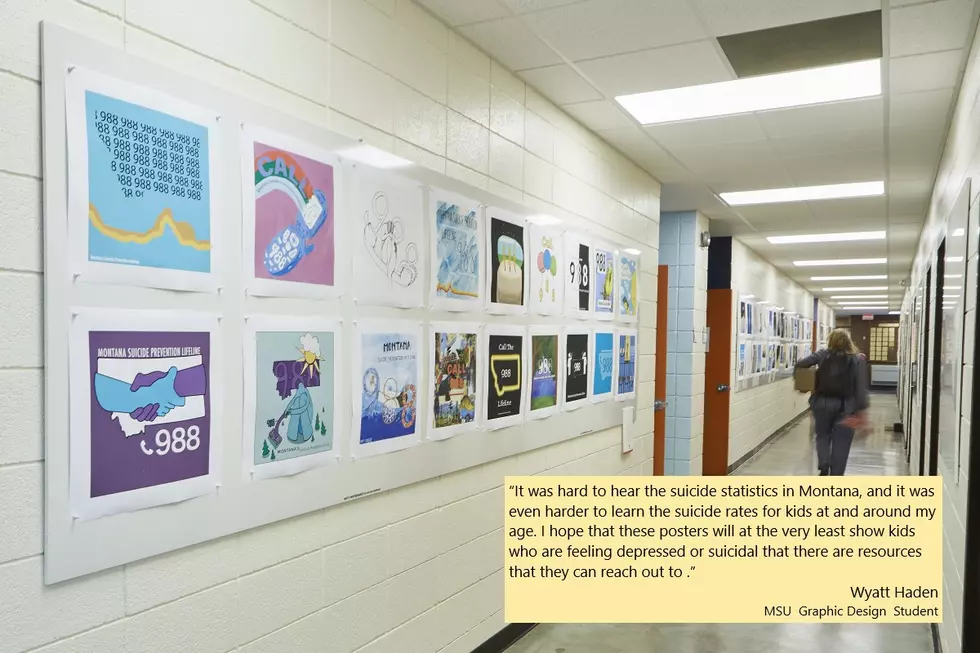
MSU Students’ Designs Featured in Montana 988 Suicide Prevention Campaign
BOZEMAN – When the state of Montana launches a new campaign July 16 to promote the new 988 suicide prevention call line, it will be using posters designed by Montana State University students as part of a yearlong project.
Representatives from office of Montana Gov. Greg Gianforte chose the 11 designs from 90 student designs produced by MSU students to illustrate suicide awareness and prevention. Five of the student designs will be made into posters, and the others used in other ways to illustrate the implementation of the national 988 suicide prevention lines and other statewide programs that will accompany it.
Starting July 16, dialing the number 988 will route persons in crisis directly to the National Suicide Prevention Lifeline, a 24/7 toll-free crisis line that provides immediate care and resources to millions of callers every year.
The student designs were produced as part of several MSU art and graphic design courses that composed the MT 988 Project. The project was led by Bruce Barnhart, instructor in the School of Art in the College of Arts and Architecture. In each course, the students first participated in educational modules that provided them information about suicide awareness and prevention then created their designs.
Barnhart said the students’ designs were professional and powerful.
“What was beautiful to me was seeing what the students came up with,” Barnhart said.
Royce Smith, dean of the College of Arts and Architecture, said the students’ work was indicative of how art can highlight important societal issues.
“Design and creativity have always had at their core the elevation of the human experience,” he said. “Bruce’s work with such talented students powerfully illustrates how the creative industries support suicide prevention and draw attention to the importance of mental health.”
Barnhart has worked for several years to develop the suicide education curriculum. He said that he was motivated to create the curriculum because, for the last 30 years, Montana has ranked among the top five states in the U.S. for suicides per capita.
Such sobering facts first led him to launch a social design project in a class several years ago that looked at the issue of suicide. In that class, as in the most recent project, Barnhart brought in local and state experts on the issue. The work done by those students caught the attention of the Montana Governor’s Office, and the students’ poster designs were printed and distributed to every high school and middle school in the state.
“What started as a simple classroom project went on to have an impact on many Montana students,” Barnhart said.
With the help of a $35,000 grant from the Arthur M. Blank Foundation, Barnhart expanded the concept and last fall trained seven graphic design instructors in the concept of the project. Students in an introductory graphic design class participated in the suicide learning module and listened to presentations about suicide education from Betsy Asserson, Brian Kassar and Levenae Buggs, psychologists with MSU’s Counseling and Psychological Services, as well as Karl Rosston, suicide prevention coordinator for the Montana Department of Public Health and Human Services.
“They gave us messages of hope and gave us pointers,” Barnhart said.
In addition to the introductory graphic design courses that included MSU students from every college, art professor Minjee Jeon adapted the module to her junior-level art classes in motion graphics, and those students created short animations geared toward suicide prevention.
In all, students created 90 posters that were submitted to the governor. All the works and the animations created for the project will be part of a traveling exhibition that will tour the state this year.
“The course (Barnhart) designed was able to help students discover the power of the art-making process to offer a sense of hope and to address a complex and difficult subject,” said Josh DeWeese, director of the School of Art. “The posters created by the students are powerful in their balance of sensitivity and direct messaging, and they will be very effective tools to get the word out about this important new resource.”
The students who participated in the course said the project was powerful to them personally and an impetus to their future careers.
“I think it’s amazing that as students (some of us only in our first year) were given the opportunity to work on such a meaningful project,” said Ella Pfeiffer, a graphic design major from Pequot Lakes, Minnesota, who chose to illustrate a ray of light in times of darkness. “I loved being able to create work that will be used for a real life cause.”
Torie Keto, a graphic design major from Spokane, Washington, said that, as someone who has known people who have taken their own life and who knows the struggles of depression, she chose a sun in bright shades in her design to provide encouragement.
“I felt like this project was a good opportunity to help,” Keto said.” I can see the 988 program being successful since it’s an easy number to remember and call. I’m glad I had gotten to be a part of it.”
Wyatt Haden, a graphic design major from Flagstaff, Arizona, said he enjoyed working on a school project that will have a positive impact in the community.
“It was hard to hear the suicide statistics in Montana, and it was even harder to learn the suicide rates for kids at and around my age. I hope that these posters will at the very least show kids who are feeling depressed or suicidal that there are resources that they can reach out to .”
Students whose work was selected for general release included Haden, Keto and Pfeiffer, as well as Carley Haskell and Rita Ramsey. Students whose work was selected for more targeted release were Madeline DeVall, DoriRose Dusl, Emerson Egloff, Dacey Lee Hayman, Jason Rigg and Ali Rysted.
For more information about the Montana 988 suicide prevention project, CLICK HERE.
- by MSU News Service -
More From K96 FM









